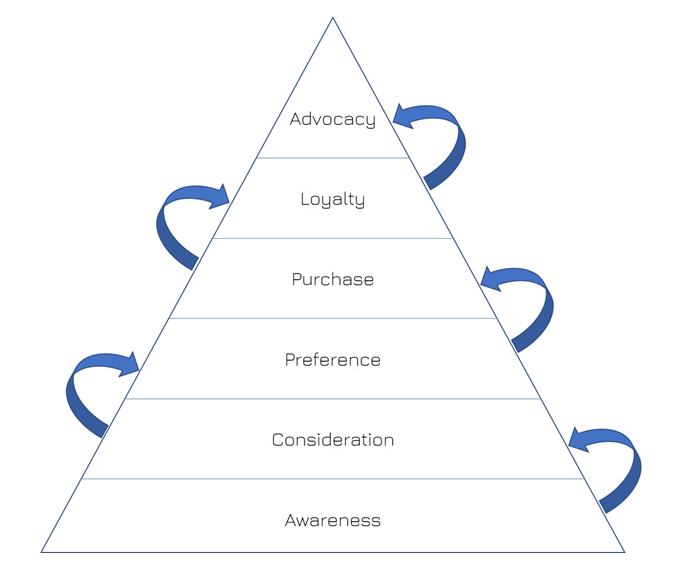Many business leaders say to me, ‘I want an advertising campaign to generate incremental sales by acquiring new customers.’ They have visions of eye-catching adverts in print or even on TV, a phone that immediately starts ringing with quality enquiries, and an order book that is bursting at the seams.
Whilst all of this is perfectly possible, it doesn’t usually happen overnight. Potential customers need to be taken on a journey; the relationship with them needs to be nurtured. Depending on the nature of the purchase, this journey may take just minutes, but will often take several weeks or months. Before designing any marketing campaign, it’s helpful to understand not only who you are targeting, but also what stage they are at in the engagement process.
There are many fancy text book models for customer engagement, many of which are unnecessarily complex. What they all boil down to is a simple progression in six steps that takes your prospect from being unaware that your business even exists, to becoming not only a loyal customer but also an advocate for your business in the wider market place. Critically, each step requires a different set of actions from your business.

Step 1 – Awareness
Potential customers need to know that your business exists and be aware of the products and services that you offer. Raising brand awareness is not difficult, but it often takes time. It is only through repeated exposure to a brand that the awareness will grow.
One of the biggest hurdles to overcome at this stage from a marketing perspective is return on investment (ROI). It’s increasingly the case that business leaders want to measure the return on their marketing spend on a monthly basis. Brand advertising can be an important tactic for raising brand awareness, but as a stand-alone activity it doesn’t tend to generate immediate sales revenue. Even if you undertake regular market research to measure brand awareness, it’s almost impossible to put a monetary value on any improvements. To make financial sense, the brand awareness activity needs to be seen as a part of a wider strategy – the first step on a path towards customer acquisition and retention – that will deliver the required ROI.
Step 2 – Consideration
Having been made aware of your business, the next step is for your prospects to find out more about the products and services your business offers. At this stage, they need to find your offer both attractive and relevant to their needs.
Your website is likely to be important at this stage, so having a well-designed site that clearly communicates what you do is essential. I think it’s always a good idea to design your website’s home page to not only include a paragraph that says what you do and for whom, but also to include a clear massage about why people should choose your business over the competition.
Step 3 – Preference
If they like what they see, and feel that your business may be able to help, the chances are that you’ll make it to the shortlist. At this point it’s important to make it easy for people to contact you. This is where the calls-to-action on your website come in. Lengthy forms to fill in and onerous data capture can put people off; it’s important to make it as easy and painless as possible for prospective customers to get in touch.
Step 4 – Purchase
So, your efforts to this point have earned you an enquiry. The chances are that your business is still one of a few others who are on the shortlist, so that enquiry needs to be managed efficiently in order to convert it to a sale. Understanding what your enquirer wants can often be key to this – there’s nothing more off-putting than talking to a business that doesn’t listen to you.
Not all of your enquiries will convert to sales, but the fact that a potential customer has seen enough relevance and shown enough interest to get in touch is important and valuable. So they may have chosen a competitor this time round, but with some good communication over the ensuing months, there’s every chance to persuade them to buy from you next time, particularly if your competitor is less attentive than you are.
Step 5 – Loyalty
You have a hard-won new customer, who if they are satisfied, may become a regular customer. But a regular customer is not necessarily a loyal one. Repeat purchase may be driven by convenience more than any allegiance to your company or brand. True loyalty is when a customer turns away one of your competitors because they are genuinely happy with the products and service that you offer and with the relationships that have been developed since their first contact with your organisation.
Loyalty is not something that happens overnight; loyalty has to be earned and nurtured over time. Building customer loyalty is not just about the relationship with the account managers, it is the responsibility of everyone within the business.
Step 6 – Advocacy
The final stage of customer engagement is advocacy, where your customer loyalty is put to good use to grow your business. Whether through word of mouth, Trust Pilot reviews or active support on social media, there is no stronger way to attract more customers than to have your existing customers extoll the virtues of your business.
This is an area that is often overlooked and is one that needs to be managed and nurtured in order to maximise its potential. Ask your customers for testimonials that you can use in your literature and on your website. Ask your customers to share your social media posts. Invite your customers to events where they can share their positive experiences with prospects who you have also invited to attend.
Integrated marketing
Your customers and prospects will be at different stages of this engagement process. What’s more, some potential customers can move through the initial steps in a matter of minutes. Your marketing activity therefore needs to address people at each stage concurrently. Whilst a good marketing strategy will be designed to target people at every step, one message can be relevant to multiple stages. Brand advertising, for example, can work to not only to build brand awareness, but can also reassure existing customers and help build loyalty.
Reach out, engage, delight
These six steps in customer engagement can be distilled down to just three:
- Reach out
- Engage
- Delight
These principles of effective marketing are so important to business success that I named my business after them. The ‘RED’ in 49Red is an acronym from these three terms.
If your business needs to engage with new customers to generate incremental sales, contact me directly to discuss how the expert team at 49Red can help.
Hugh Moss
07808 365214



